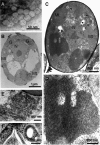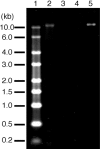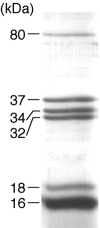Isolation and characterization of a novel single-stranded RNA Virus infectious to a marine fungoid protist, Schizochytrium sp. (Thraustochytriaceae, Labyrinthulea)
- PMID: 16085844
- PMCID: PMC1183295
- DOI: 10.1128/AEM.71.8.4516-4522.2005
Isolation and characterization of a novel single-stranded RNA Virus infectious to a marine fungoid protist, Schizochytrium sp. (Thraustochytriaceae, Labyrinthulea)
Abstract
Thraustochytrids are cosmopolitan osmoheterotrophic microorganisms that play important roles as decomposers, producers of polyunsaturated fatty acids, and pathogens of mollusks, especially in coastal ecosystems. SssRNAV, a novel single-stranded RNA (ssRNA) virus infecting the marine fungoid protist Schizochytrium sp. (Labyrinthulea, Thraustochytriaceae) was isolated from the coastal water of Kobe Harbor, Japan, in July 2000, and its basic characteristics were examined. The virus particle is icosahedral, lacks a tail, and is ca. 25 nm in diameter. SssRNAV formed crystalline arrays and random assemblies within the cytoplasm of host cells, and it was also concentrated along the intracellular membrane structures. By means of one-step growth experiments, the lytic cycle and the burst size were estimated to be <8 h and 5.8 x 10(3) to 6.4 x 10(4) infectious units per host cell, respectively. SssRNAV had a single molecule of ssRNA that was approximately 10.2 kb long, three major proteins (37, 34, and 32 kDa), and two minor proteins (80 and 18 kDa). Although SssRNAV was considered to have some similarities with invertebrate viruses belonging to the family Dicistroviridae based on its partial nucleotide sequence, further genomic analysis is required to determine the detailed classification and nomenclature of SssRNAV. Our results indicate that viral infection is one of the significant factors controlling the dynamics of thraustochytrids and provide new insights into understanding the ecology of these organisms.
Figures





Similar articles
-
Isolation and characterization of a single-stranded RNA virus infecting the marine planktonic diatom Chaetoceros tenuissimus Meunier.Appl Environ Microbiol. 2008 Jul;74(13):4022-7. doi: 10.1128/AEM.00509-08. Epub 2008 May 9. Appl Environ Microbiol. 2008. PMID: 18469125 Free PMC article.
-
Complete nucleotide sequence and genome organization of a single-stranded RNA virus infecting the marine fungoid protist Schizochytrium sp.J Gen Virol. 2006 Mar;87(Pt 3):723-733. doi: 10.1099/vir.0.81204-0. J Gen Virol. 2006. PMID: 16476996
-
Isolation and characterization of a novel single-stranded RNA virus infecting the bloom-forming diatom Rhizosolenia setigera.Appl Environ Microbiol. 2004 Feb;70(2):704-11. doi: 10.1128/AEM.70.2.704-711.2004. Appl Environ Microbiol. 2004. PMID: 14766545 Free PMC article.
-
RNA Viruses in Aquatic Unicellular Eukaryotes.Viruses. 2021 Feb 25;13(3):362. doi: 10.3390/v13030362. Viruses. 2021. PMID: 33668994 Free PMC article. Review.
-
The family narnaviridae: simplest of RNA viruses.Adv Virus Res. 2013;86:149-76. doi: 10.1016/B978-0-12-394315-6.00006-4. Adv Virus Res. 2013. PMID: 23498906 Review.
Cited by
-
Are we missing half of the viruses in the ocean?ISME J. 2013 Mar;7(3):672-9. doi: 10.1038/ismej.2012.121. Epub 2012 Nov 15. ISME J. 2013. PMID: 23151645 Free PMC article.
-
New genera of RNA viruses in subtropical seawater, inferred from polymerase gene sequences.Appl Environ Microbiol. 2007 Sep;73(18):5937-44. doi: 10.1128/AEM.01065-07. Epub 2007 Jul 20. Appl Environ Microbiol. 2007. PMID: 17644642 Free PMC article.
-
Eukaryotic Microbial RNA Viruses-Acute or Persistent? Insights into Their Function in the Aquatic Ecosystem.Microbes Environ. 2022;37(5):ME22034. doi: 10.1264/jsme2.ME22034. Microbes Environ. 2022. PMID: 35922920 Free PMC article. Review.
-
Isolation and characterization of a single-stranded RNA virus infecting the marine planktonic diatom Chaetoceros tenuissimus Meunier.Appl Environ Microbiol. 2008 Jul;74(13):4022-7. doi: 10.1128/AEM.00509-08. Epub 2008 May 9. Appl Environ Microbiol. 2008. PMID: 18469125 Free PMC article.
-
Global morphological analysis of marine viruses shows minimal regional variation and dominance of non-tailed viruses.ISME J. 2013 Sep;7(9):1738-51. doi: 10.1038/ismej.2013.67. Epub 2013 May 2. ISME J. 2013. PMID: 23635867 Free PMC article.
References
-
- Azevedo, C., and L. Corral. 1997. Some ultrastructural observations of a thraustochytrid (Protoctista, Labyrinthulomycota) from the clam Ruditapes descussatus (Mollusca, Bivalvia). Dis. Aquat. Org. 31:73-78.
-
- Bahnweg, G., and F. K. Sparrow. 1972. Aplanochytrium kerguelensis gen. nov. spec. nov., a new phycomycete from subantarctic marine waters. Arch. Microbiol. 81:45-49. - PubMed
-
- Bergh, Ø., K. Y. Børsheim, G. Bratbak, and M. Heldal. 1989. High abundance of viruses found in aquatic environments. Nature 340:467-468. - PubMed
-
- Bratbak, G., J. K. Egge, and M. Heldal. 1993. Viral mortality of the marine alga Emiliania huxleyi (Haptophyceae) and termination of algal blooms. Mar. Ecol. Prog. Ser. 93:39-48.
-
- Brussaard, C. P. D. 2004. Viral control of phytoplankton populations—a review. J. Eukaryot. Microbiol. 51:125-138. - PubMed
Publication types
MeSH terms
Substances
LinkOut - more resources
Full Text Sources
Medical

